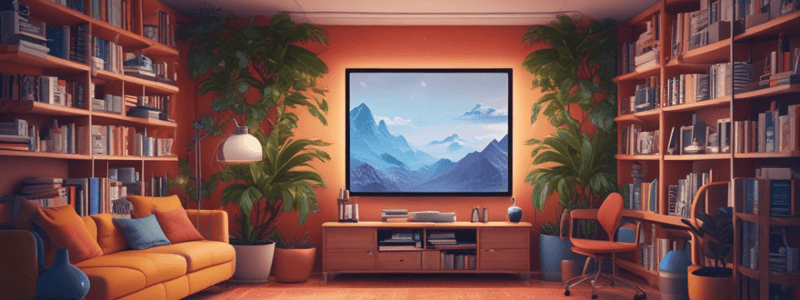Podcast
Questions and Answers
¿Cuál es el propósito principal de las líneas en el diseño de maquetas?
¿Cuál es el propósito principal de las líneas en el diseño de maquetas?
- Crear formas geométricas complejas
- Agregar claridad, dirección y definición al diseño (correct)
- Dividir el espacio en secciones iguales
- Resaltar el uso de colores brillantes
¿Qué tipo de líneas se suelen usar para los encabezados en las maquetas?
¿Qué tipo de líneas se suelen usar para los encabezados en las maquetas?
- Líneas gruesas y sólidas (correct)
- Líneas delgadas y discontinuas
- Líneas onduladas y multicolores
- Líneas finas y puntiagudas
¿Cuál de las siguientes formas geométricas NO se suele utilizar en el diseño de maquetas?
¿Cuál de las siguientes formas geométricas NO se suele utilizar en el diseño de maquetas?
- Rectángulos
- Octágonos (correct)
- Triángulos
- Círculos
¿Cómo pueden usarse las formas en las maquetas?
¿Cómo pueden usarse las formas en las maquetas?
¿Cuál es el principal papel que juega el color en el diseño de maquetas?
¿Cuál es el principal papel que juega el color en el diseño de maquetas?
¿Qué efecto pueden tener los colores en las maquetas?
¿Qué efecto pueden tener los colores en las maquetas?
¿Qué elemento del diseño se refiere a las áreas vacías alrededor y entre los objetos?
¿Qué elemento del diseño se refiere a las áreas vacías alrededor y entre los objetos?
¿Cuál es la función principal del valor en un diseño?
¿Cuál es la función principal del valor en un diseño?
¿Qué pueden crear las texturas en un mockup de diseño?
¿Qué pueden crear las texturas en un mockup de diseño?
¿Qué elementos del diseño pueden estimular sentimientos de energía y emoción?
¿Qué elementos del diseño pueden estimular sentimientos de energía y emoción?
¿Qué dimensión de un objeto se representa a través de sombras, texturas y perspectiva?
¿Qué dimensión de un objeto se representa a través de sombras, texturas y perspectiva?
¿Qué aspecto puede crear guía visual en un diseño de mockup?
¿Qué aspecto puede crear guía visual en un diseño de mockup?
Flashcards are hidden until you start studying
Study Notes
Design Elements in Mockups
Design elements are crucial components that contribute to the overall aesthetics and user experience of a product or service. Mockups serve as visual representations of these elements within a design context. Let's delve deeper into seven fundamental visual elements of design and discuss how they are incorporated into mockups.
Line
Lines add clarity, direction, and definition to mockup designs. Depending on the desired effect, lines can range from thick to thin, solid to dashed, and monochromatic to multicolored. Thicker lines can be used for headings, while thinner ones can separate text or illustrations within the mockup. Additionally, lines can be utilized to create curves, angles, and geometric shapes that enhance the design's visual appeal.
Shape
Shapes are fundamental building blocks in any visual design, including mockups. They can be simple or complex, regular or irregular, straight or curved. Common shapes used in mockups include circles, squares, triangles, hexagons, rectangles, and ellipses. Shapes can be filled with colors, gradients, or textures to add depth and contrast to the design. They can also be employed to divide sections of a mockup into distinct areas or to highlight important information.
Color
Color plays a significant role in setting the tone and mood of a mockup design. Colors can evoke emotions and convey meaning to users. Warm colors like red, orange, and yellow can stimulate feelings of energy and excitement, while cool colors like blue, green, and purple can create a calming and relaxing atmosphere. Choosing appropriate color schemes that complement the brand identity and target audience is essential in ensuring a successful mockup.
Value
Value refers to the lightness and darkness of an object or area in a design. This aspect is critical in determining the overall visual hierarchy of a mockup. Light values are typically associated with highlights, while dark values signify shadows. Carefully manipulating the value of elements within a mockup can create depth and dimension, guiding the user's eyes to focus on specific areas.
Form
Form encompasses the three dimensions of an object: length, width, and height. In mockups, forms can be represented through shading, texture, and perspective. Utilizing these techniques effectively can create a sense of depth and realism, allowing users to envision the product or service in a tangible manner.
Texture
Texture adds physicality and tactility to mockup designs. Through the application of different textures, artists can create a sense of surface quality or material properties. This not only enhances the visual appeal of the mockup but also allows users to better comprehend the intended use or function of the product or service being presented.
Space
Space refers to the empty areas around and between objects in a design. In mockups, careful consideration of space can significantly influence the overall composition and coherence of the design. Proper utilization of space can improve legibility, ease of navigation, and overall user experience.
By understanding these seven visual elements of design and incorporating them appropriately in mockups, designers can create visually compelling and engaging products that resonate with their audiences.
Studying That Suits You
Use AI to generate personalized quizzes and flashcards to suit your learning preferences.




